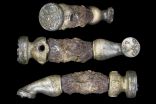Scientists identify potential cause for 40 percent of pre-term births
2014-10-14
(Press-News.org) Scientists from Queen Mary University of London (QMUL) and UCL (University College London) have identified what they believe could be a cause of pre-term premature rupture of the fetal membrane (PPROM), which accounts for 40 per cent of pre-term births, and is the main reason for infant death world-wide.
The researchers, whose work was funded by the charity Wellbeing of Women, used bioengineering techniques to test the effect of repetitive stretch on tissues of the amniotic membrane which surrounds and protects the baby prior to birth.
They found that stretching of the amniotic membrane leads to the overproduction of prostaglandin E2 (PGE2) which is damaging to both the cells, and mechanical structure, of the tissue. This overproduction activates the stretch-sensitive protein connexin 43 (Cx43) and reduces the mechanical properties of the membrane, potentially leading to rupture and pre-term birth.
The research, published today (Monday) by the journal Placenta, is the first study to investigate the role of Cx43 in causing PPROM.
The team are now researching possible treatments that would allow the amniotic membrane to be repaired, through successful funding by the Rosetrees Trust.
Co-author of the research, Dr Tina Chowdhury from the School of Engineering and Material Sciences at Queen Mary University of London, said:
"To have potentially found a way to reduce pre-term births and prevent early deaths of young babies worldwide is incredibly exciting. The unique bioengineering tools at QMUL have allowed us to test the tissue in a way that has never been done before. This gives us an understanding of both the mechanical as well as biological mechanisms involved and will help us to develop therapies that will reduce the number of pre-term births."
Dr Anna David, a consultant in obstetrics and pre-term birth from the UCL Institute for Women's Health and a co-author of the paper, said:
"Our findings have provided a new understanding of why pregnant women who have pre-term contractions go on to rupture their membranes early. The new project funded by the Rosetrees Trust could lead to a therapy that will heal the amniotic membrane and reduce preterm births. This has the potential to save many lives worldwide and improve the health and well-being of women during pregnancy and their families after birth."
Sam Howard, CEO at Rosetrees Trust, said:
"The findings are extremely encouraging and show the value of conducting early stage research into biological mechanisms. This piece in the puzzle may lead to novel treatment strategies to reduce pre-term birth, the main cause of infant death world-wide. Rosetrees Trust is delighted to be able to support such cutting edge research carried out by outstanding researchers such as Dr Tina Chowdhury and Dr Anna David, which has a direct human impact."
Liz Campbell, Director at Wellbeing of Women, said:
"Wellbeing of Women is committed to funding research which looks at the possible causes of premature birth and offers safe and effective solutions. Premature birth can be very dangerous for mother and baby; and is particularly devastating when babies die. Almost half of premature births occur as a result of waters breaking too early and up until now doctors have not been able to say why this happens.
"This study, co funded by Wellbeing of Women, helps explain why some amniotic sacs, which protect the baby as it grows inside the womb, are more prone to breaking too early - which can lead to premature birth. Going forward, we can now focus on new treatments to address this weakness in the womb tissue and help women who have had previous preterm births feel more confident about their pregnancies and their ability to carry a pregnancy to full term."
INFORMATION:
http://www.placentajournal.org/article/S0143-4004(14)00782-6/abstract END
ELSE PRESS RELEASES FROM THIS DATE:
2014-10-14
New York | Heidelberg, 13 October 2014 Increasing reliance on renewable energies is the way to achieve greater CO2 emission sustainability and energy independence. As such energies are yet only available intermittently and energy cannot be stored easily, most countries aim to combine several energy sources. In a new study in EPJ Plus, French scientists have come up with an open source simulation method to calculate the actual cost of relying on a combination of electricity sources. Bernard Bonin from the Atomic Energy Research Centre CEA Saclay, France, and colleagues demonstrate ...
2014-10-14
Scientists from Nanyang Technological University (NTU Singapore) have developed a new battery that can be recharged up to 70 per cent in only 2 minutes. The battery will also have a longer lifespan of over 20 years.
Expected to be the next big thing in battery technology, this breakthrough has a wide-ranging impact on many industries, especially for electric vehicles which are currently inhibited by long recharge times of over 4 hours and the limited lifespan of batteries.
This next generation of lithium-ion batteries will enable electric vehicles to charge 20 times ...
2014-10-14
In the context of an aging population, the number of cases of people with multimorbidity, or multiple health conditions, is increasing, creating significant healthcare challenges. Now, the first comprehensive systematic review in this field has found higher levels of multimorbidity in women. Equally as importantly, it has revealed the poor quality of evidence on this increasingly critical area of healthcare.
The review's main author, Professor Jose M Valderas, NIHR Clinician Scientist of the University of Exeter Medical School, is calling for better quality research to ...
2014-10-14
Biomedical engineering researchers have developed a drug delivery system consisting of nanoscale "cocoons" made of DNA that target cancer cells and trick the cells into absorbing the cocoon before unleashing anticancer drugs. The work was done by researchers at North Carolina State University and the University of North Carolina at Chapel Hill.
"This drug delivery system is DNA-based, which means it is biocompatible and less toxic to patients than systems that use synthetic materials," says Dr. Zhen Gu, senior author of a paper on the work and an assistant professor in ...
2014-10-14
Scientists at the Luxembourg Centre for Systems Biomedicine (LCSB) of the University of Luxembourg have published their findings that mutations in a gene known as "ARMC5" promote the growth of benign tumours in the adrenal glands and on the meninges: ARMC5 appears to belong to the group of so-called tumour suppressor genes. It is the first time in years that scientists have characterized such a gene.
The ARMC5 gene was discovered by independent workgroups studying benign tumours – so-called adrenal adenomas – in connection with Cushing's syndrome. In this ...
2014-10-14
University of Leicester archaeologists have made a "once-in-a-career" discovery of the decorated bronze remains of an Iron Age chariot.
A team from the University's School of Archaeology and Ancient History has unearthed a hoard of rare bronze fittings from a 2nd or 3rd century BC chariot which appears to have been buried as a religious offering.
The archaeologists found the remains during their ongoing excavation of the Burrough Hill Iron Age hillfort, near Melton Mowbray, Leicestershire.
The School has led a 5-year project there since 2010, giving archaeology students ...
2014-10-14
Parkinson's disease is strongly linked to the degeneration of the brain's movement center. In the last decade, the question of where the disease begins has led researchers to a different part of the human anatomy. In 2003, the German neuropathologist Heiko Braak presented a theory suggesting that the disease begins in the gut and spreads to the brain. The idea has since, despite vocal critics, gained a lot of ground. Researchers at Lund University in Sweden now present the first direct evidence that the disease can actually migrate from the gut to the brain.
The so-called ...
2014-10-14
Chemists at Ludwig-Maximilias-Universitaet (LMU) in Munich have synthesized a ferromagnetic superconducting compound that is amenable to chemical modification, opening the route to detailed studies of this rare combination of physical properties.
Superconductivity and ferromagnetism – the "normal" form of magnetism, such as that found in the familiar horseshoe magnet – are like chalk and cheese: They generally don't go together. Ferromagnets are magnetic because the parallel alignment of adjacent electron spins in the iron atoms generates a strong internal ...
2014-10-14
The climate is getting warmer, the ice sheets are melting and sea levels are rising – but how much? The report of the UN's Intergovernmental Panel on Climate Change (IPCC) in 2013 was based on the best available estimates of future sea levels, but the panel was not able to come up with an upper limit for sea level rise within this century. Now researchers from the Niels Bohr Institute and their colleagues have calculated the risk for a worst-case scenario. The results indicate that at worst, the sea level would rise a maximum of 1.8 meters. The results are published ...
2014-10-14
WASHINGTON, Oct. 13, 2014 — Whether it's a plain cheese, a deep-dish stacked with meats or a thin-crust veggie delight, there's just something about pizza that makes it delicious. There's a lot of chemistry that goes into everything from dough to sauce to toppings to, of course, cheese. There's also a very specific chemical reaction at work on every single slice, no matter what toppings you choose. Check out the latest episode here: http://youtu.be/tOkCgAwhh9U.
Subscribe to the series at Reactions YouTube, and follow us on Twitter @ACSreactions to be the first to ...
LAST 30 PRESS RELEASES:
[Press-News.org] Scientists identify potential cause for 40 percent of pre-term births




